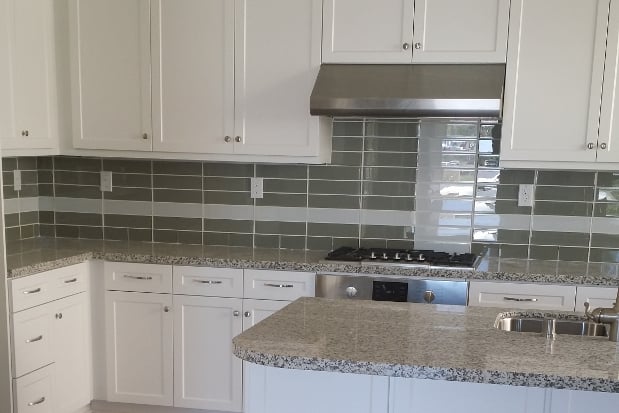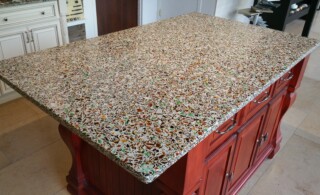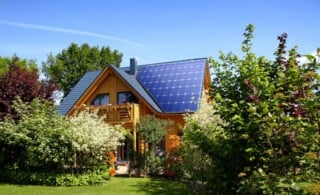
Laminate countertops present an interesting dilemma for homeowners looking to go green. In truth, there are more eco-friendly options out there when it comes to countertop materials. Laminate countertops can contain high levels of adhesives, sealers, and other sources of potentially harmful volatile organic compounds (VOCs) that get released into your indoor environment. On the other hand, laminate countertops are a cost effective, functional, and attractive option for homeowners remodeling on a budget. That being the case, there are many steps you can take that will help you to transform this not-so-green countertop material into something a few shades greener. Here’s a guide from HomeAdvisor on what you can do if you’re interested in going green with laminate counters.
Green Remodeling 101: Calculating Value
For starters, let’s talk cost. Budget is a big concern on any remodeling project, and the high cost of many kitchen and bathroom remodels can cause homeowners to balk at the prospect of spending even more by going green. However, the truth of the matter is that eco-friendly laminate rarely costs much more than a conventional laminate installation, and in many cases, it can actually end up saving you money. In addition, the true value of green remodeling is far higher than any calculation involving dollars and cents. Things like higher quality countertops, longer lasting materials, and most of all, healthier homes, are far more valuable than any budget can reflect. Add to that the peace of mind that comes in knowing you’ve made a commitment to a better, more sustainable world for your kids and grandkids, and the real value of going green starts to come into focus.
How to Green Your Countertop Project
Just what can you do to make sure your new laminate counters are as green as they come? There are several suggestions, ranging from how you can reduce health risks related to your countertops to how to manage your job site and waste materials, which will help you achieve the most eco-friendly laminate countertops possible.
- Avoid Particleboard, MDF, and Interior Grade Plywood—Almost all laminate surfaces are installed over a solid substrate that makes up the heart of your new countertops. Unfortunately, particleboard, medium density fiberboard (MDF), and interior grade plywood are some of the most popular substrate materials used and all of them can off-gas carcinogenic formaldehyde into your indoor air for years after installation.
- Use Exterior Grade Plywood, Solid Wood, or Formaldehyde-Free MDF—Instead of using conventional MDF or interior grade plywood, request that your contractor use exterior grade plywood, solid wood, or formaldehyde-free MDF as the substrate material. All are much healthier options for everyone under your roof.
- Seal Exposed Particleboard, MDF, and Interior Grade Plywood—If you choose to use one of these materials anyway, be sure to seal all exposed areas with a low- or no-VOC paint or sealer prior to installation. Doing so will help to drastically reduce the level VOCs that escape into your home.
- Use Solvent Free Adhesives—Solvent based adhesives off-gas toxic VOCs into your indoor air for months after they are applied. If you use adhesives any time during your countertop installation, be sure to use a solvent free, environmentally friendly product.
- Seal Up all Countertop Materials and Beware of Water Damage—While laminate countertops provide a relatively solid surface to protect against moisture penetration and bacteria development, there is always the risk of water getting through cracks, joints, and other areas, and reaching the substrate beneath. If that happens, your laminate will likely fail and there will be an increased risk of mold development that can lead to a host of serious health issues. Make sure your laminate countertops are installed, sealed, and caulked properly, especially around sinks and in other high moisture areas.
- Reuse and Recycle Old Materials—As much as 85 percent of the construction waste sent to landfills can be recycled and used in other construction projects. If you’re tearing up an old countertop to put in a new one, be sure to reuse what you can (old trim, etc.), and send any recyclable waste materials (such as reusable ceramic tile) somewhere besides the dump.
Ready to start your Laminate Countertops?
Find ProsWhich Shade of Green is Right for You?
While thinking green when it comes to laminate countertops is a smart choice for your pocketbook, your health, and the environment, it’s not unusual for homeowners to feel a little overwhelmed when presented with the full scope of options. If you’re feeling unsure about how earth-friendly you’re willing to go with your laminate countertops, there’s no need to worry. Going green isn’t an all-or-nothing proposition, and any step you take in a green direction is a smart one, whether you use a solvent free adhesive to install your laminate, or go green from the substrate up.
If you do think going green is the right thing to do for your new laminate countertops, talk with your contractor about adopting a green remodeling philosophy, find a contractor who specializes in green building and remodeling, or seek out the services of a green consulting firm so that you can be sure your new countertops are as green as they come.
 Recycled Glass Countertops – Sustainability & Strength
Recycled Glass Countertops – Sustainability & Strength  Marble Countertops
Marble Countertops  Sustainable Home Improvements that Help Save the Planet
Sustainable Home Improvements that Help Save the Planet  Green Building Glossary
Green Building Glossary  Green Kitchens
Green Kitchens 

Are You Familiar With This Topic? Share Your Experience.